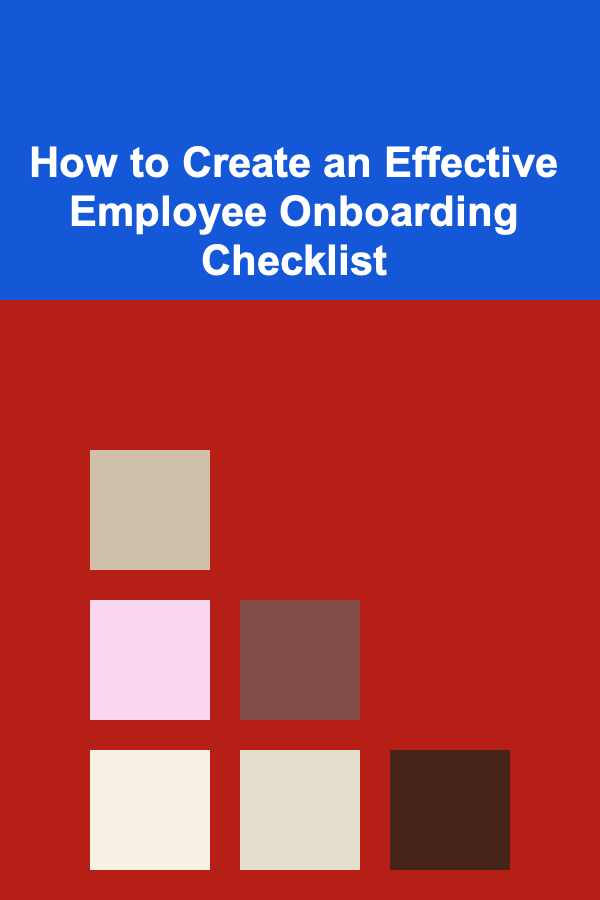
How to Create an Effective Employee Onboarding Checklist
ebook include PDF & Audio bundle (Micro Guide)
$12.99$10.99
Limited Time Offer! Order within the next:

Employee onboarding is a critical process in ensuring that new hires are integrated smoothly into your company. A well-organized and thorough onboarding experience not only helps new employees feel welcomed but also sets the stage for their long-term success within the company. One of the best ways to ensure that the onboarding process is effective is by creating a comprehensive employee onboarding checklist. This checklist serves as a structured guide to help HR teams and managers stay organized and ensure that all necessary tasks are completed.
In this actionable guide, we'll walk you through how to create an employee onboarding checklist that can streamline the process, enhance the new hire experience, and contribute to better employee retention.
Start with Pre-Onboarding
The onboarding process should begin before the employee even steps foot into the office. Pre-onboarding activities lay the foundation for the new hire's first day and create a sense of anticipation and excitement.
Key Pre-Onboarding Tasks:
- Send a Welcome Email: This email should include essential information such as the employee's first day, office location (or virtual meeting details), dress code, and a brief introduction to the team or company culture.
- Provide Company Documents: Share any paperwork that needs to be filled out before the first day, such as tax forms, direct deposit details, and benefits enrollment. You can use e-signature tools to streamline this process.
- Set Up IT Systems and Equipment: Make sure that the new hire's workspace (whether physical or remote) is ready. This includes setting up computers, email accounts, software access, and any hardware like headsets or phones.
- Share a Pre-Onboarding Survey: Use a pre-employment survey to gather some background on the new employee, including their expectations, interests, and preferred learning styles. This can help tailor their onboarding experience.
Actionable Tip:
Ensure that all documentation is easily accessible and user-friendly. Sending over documents well in advance gives new hires ample time to review and ask questions before their first day.
First Day Checklist
The first day of onboarding is a critical opportunity to make a great first impression and ensure the new hire feels welcome. A successful first day can set the tone for their entire experience with your company.
Key First Day Tasks:
- Welcome and Introduction: Greet the new hire personally, introduce them to the team, and give them a tour of the office (if applicable). If remote, schedule a virtual meeting with key team members.
- Orientation: Offer a company orientation that covers essential information such as company history, values, vision, and mission. Be sure to highlight the company's culture and key policies (e.g., dress code, work hours, confidentiality).
- Set Up the Workspace: Ensure the new employee has everything they need, from office supplies to the computer and email accounts set up. For remote employees, make sure they have access to all necessary software tools and resources.
- IT Setup: Verify that the new hire has access to company systems, email, and other essential software. Walk them through setting up their accounts and any necessary tools.
- Provide Employee Handbook: Provide an employee handbook or digital version and go through any key policies regarding HR, security, and the work environment.
- Schedule Introductory Meetings: Arrange initial meetings with managers, HR representatives, and team members. This fosters early connections and offers insight into what the employee's role will be.
Actionable Tip:
Avoid overwhelming the new hire with too much information on the first day. The focus should be on essential introductions and tools needed for their role.
Week One Checklist
The first week is an opportunity for the new employee to start settling into their role and begin learning the ropes. By the end of the first week, the new hire should feel comfortable with basic tasks and workflows, as well as have a clear understanding of their responsibilities.
Key Week One Tasks:
- Role-Specific Training: Start with an introduction to the core functions of their role. Provide them with the training materials, manuals, or systems they'll need to start performing their duties.
- Team Integration: Organize team lunches or informal meetings so that the new hire can meet colleagues in a less formal setting. Encourage team members to offer support during the early transition period.
- Set Expectations and Goals: Meet with the new employee to set clear expectations for their role in the short-term and long-term. Set measurable goals that they can work towards in the first few months.
- Mentorship Program: If possible, assign a mentor or buddy within the team. This can provide guidance and a direct line of support for the new employee.
- Feedback and Check-ins: Schedule regular check-ins throughout the first week to assess how the new hire is doing, offer guidance, and ask for feedback on the onboarding process.
- Encourage Social Integration: Help the new hire integrate into the company culture by encouraging participation in social activities, team-building exercises, or community events.
Actionable Tip:
Provide the new hire with a clear roadmap of what to expect during their first few weeks. This helps set realistic expectations and reduces any anxiety about what lies ahead.
Month One Checklist
By the end of the first month, the employee should have started mastering the basics of their role. This is the time to provide more advanced training, deepen their understanding of the company's mission, and assess their performance.
Key Month One Tasks:
- Advanced Role-Specific Training: Start providing more advanced and detailed training, which includes specific software, tools, or procedures the new hire will use in their day-to-day work.
- Performance Review: Conduct a formal check-in or performance review with the new hire to assess how they're settling into the role. Discuss their accomplishments, areas of improvement, and any challenges they've encountered.
- Introduce Company-Wide Processes: Familiarize the new hire with company-wide processes such as meeting protocols, reporting structures, and communication expectations.
- Cross-Departmental Introductions: Allow the new hire to meet with other departments they'll interact with regularly. This fosters collaboration and gives them a broader understanding of the company's structure and operations.
- Continue Social Integration: Organize social activities and events to help the new hire bond with their colleagues and further immerse them in the company culture.
Actionable Tip:
Create a feedback loop for the new hire to share their experience with the onboarding process. This allows you to make adjustments and improvements to ensure future onboarding is even better.
Ongoing Support and Development
Onboarding doesn't end after the first month. In fact, continuous support and development are critical for ensuring employee success. Ongoing training and development help keep the employee engaged and enable them to grow within the company.
Key Ongoing Tasks:
- Continuing Education: Provide opportunities for professional development, such as attending webinars, conferences, or offering online courses. This demonstrates a commitment to their long-term growth.
- Frequent Check-ins: Schedule regular check-ins with the new hire, particularly during their first six months, to provide ongoing support, offer feedback, and address any concerns.
- Assess Fit and Satisfaction: At the 3-month and 6-month marks, evaluate whether the new hire is still a good fit for the role and the company. Offer constructive feedback, and adjust roles and responsibilities as needed.
- Encourage Career Growth: Work with the new hire to develop a career growth plan. Discuss future opportunities within the company and the skills needed to advance.
Actionable Tip:
Make sure to maintain open lines of communication throughout the employee's journey. Regular check-ins and feedback loops are vital to building trust and ensuring that the employee feels valued and supported.
Conclusion
An effective employee onboarding checklist is a vital tool for creating a smooth, organized, and engaging experience for new hires. It ensures that important tasks are completed, sets the stage for long-term success, and fosters a positive relationship between the new employee and the company. By taking a structured approach to onboarding, you'll not only help new hires feel welcomed and supported but also increase their chances of success and retention within the organization.
Remember that onboarding is not just a task to be checked off, but an ongoing process that requires continuous improvement. Regularly assess and update your checklist to ensure that it remains effective and relevant to the evolving needs of your organization and your employees.
Reading More From Our Other Websites
- [Home Security 101] How to Make the Most of Fake Security Cameras in Your Home Security Strategy
- [Hiking with Kids Tip 101] Customizing Your Child's Hiking First-Aid Kit for Different Terrains and Seasons
- [Personal Care Tips 101] How to Layer Blush for a Multi-Dimensional Look
- [Organization Tip 101] How to Use Baskets for Small Music Accessories
- [Home Maintenance 101] How to Achieve a Lush, Green Lawn: A Comprehensive Lawn Care and Landscaping Guide
- [Organization Tip 101] How to Organize Your Kitchen for a Seamless Move
- [Organization Tip 101] How to Prioritize What to Keep and What to Let Go
- [Home Storage Solution 101] How to Enhance Your Kitchen with Smart Storage Ideas
- [Home Budget 101] How to Use a Home Budget Planner to Prepare for Seasonal Expenses
- [Personal Care Tips 101] Strengthening Your Pelvic Floor: A Comprehensive Guide to Targeted Exercises

How to Clean Your Home Efficiently in Just 30 Minutes a Day
Read More
How to Perform Stock Market Analysis for Profit
Read More
How to Start a Craft Business from Home with Low Startup Costs
Read More
The Joy of Connection: Building Meaningful Relationships in All Areas of Life
Read More
How To Write Effective White Papers: A Comprehensive Guide
Read More
How to Write Clean and Maintainable JavaScript Code
Read MoreOther Products

How to Clean Your Home Efficiently in Just 30 Minutes a Day
Read More
How to Perform Stock Market Analysis for Profit
Read More
How to Start a Craft Business from Home with Low Startup Costs
Read More
The Joy of Connection: Building Meaningful Relationships in All Areas of Life
Read More
How To Write Effective White Papers: A Comprehensive Guide
Read More